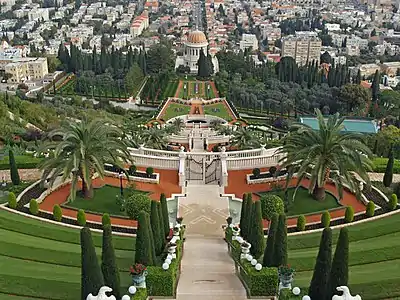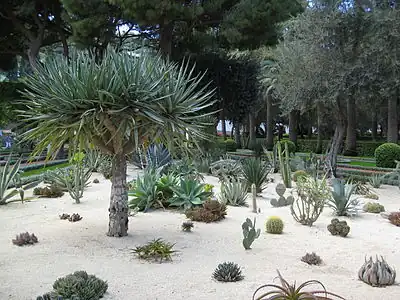
The Baháʼí Terraces, or the Hanging Gardens of Haifa, are garden terraces on Mount Carmel in Haifa, and one of the most popular tourist destinations in Israel. Completed in 2001, there are 19 terraces and more than 1,500 steps ascending the mountain.[1] The central terrace has the Shrine of the Báb, one of the main religious sites of the Baháʼí Faith. The architect was Fariborz Sahba from Iran, and the structural engineers were Karban and Co. from Haifa.
The terraces are part of a complex of Baháʼí holy places in Haifa, Acre, and western Galilee that were inscribed as a UNESCO World Heritage Site in July 2008.[2][3]
The gardens rest in the neighborhoods of Wadi Nisnas and Hadar HaCarmel.
Symbolism
The terraces represent the first eighteen disciples of the Báb, who were designated "Letters of the Living",[4] although no terraces are connected with particular individuals.[5]
Design
Nine concentric circles provide the main geometry of the eighteen terraces. Just as the identification of a circle presupposes a centre, so the terraces have been conceived as generated from the Shrine of the Báb. The eighteen terraces plus the one terrace of the Shrine of the Báb make nineteen terraces total. Nineteen is a significant number within both the Baháʼí and Bábí religions.
The gardens have elements of the Persian gardens of Shiraz, Iran, the Nishat Bagh gardens of Jammu and Kashmir, India and English gardens,[6][7] isolating the site from the noise of the surroundings and connecting the different Baháʼí buildings on Mount Carmel together.[8]
Fariborz Sahba began work in 1987 designing the gardens and oversaw construction. The terraces were opened to the public in June 2001.[9] Beginning at its base, the gardens extend almost one kilometre (0.6 miles) up the side of Mount Carmel, covering some 200,000 square metres (2,152,782 square feet) of land. The gardens are linked by a set of stairs flanked by twin streams of running water cascading down the mountainside through the steps and terrace bridges.[10]
Water and ecology
The irrigation system includes a computer which, based on meteorologic data it receives, controls hundreds of valves to distribute water throughout the gardens by sprinkling and dripping. This is done at night and in the early morning, to avoid wasting water by evaporation. The water that flows alongside the stairs is circulating in a closed system within each terrace, so that little water is wasted.[11]
Tourism
In 2013, 917,031 tourists and 8,000 Baháʼí pilgrims visited the gardens.[12]
Haifa's Mayor Amram Mitzna described the gardens as the eighth wonder of the world. "We have been very lucky," he said, "not many cities get a park that is so incredibly beautiful – free of charge."[1]
Gallery
 Aerial view of the bridge terrace behind the Shrine of the Báb
Aerial view of the bridge terrace behind the Shrine of the Báb Downward view of the upper terraces
Downward view of the upper terraces Downward view of the upper terraces
Downward view of the upper terraces Terraces at night
Terraces at night Cactus garden near the Shrine of the Báb
Cactus garden near the Shrine of the Báb
See also
References
- 1 2 "The Baha'i Gardens". www.jewishvirtuallibrary.org. Retrieved 2021-02-28.
- ↑ UNESCO World Heritage Centre (2008-07-08). "Three new sites inscribed on UNESCO's World Heritage List". Retrieved 2008-07-08.
- ↑ World Heritage Committee (2007-07-02). "Convention concerning the protection of the world cultural and natural heritage" (PDF). p. 34. Retrieved 2008-07-08.
- ↑ Info.bahai.org: The Projects on Mount Carmel
- ↑ "UHJ letter: Letters of Living; Dawn-Breakers; Quddus; Terraces". Archived from the original on 2016-03-03. Retrieved 2009-03-31.
- ↑ "Design Features of the Terraced Gardens on Mount Carmel". Archived from the original on 2012-01-23. Retrieved 2012-02-28.
- ↑ Afnan, Elham (2002). Symbols of Transformation: The Gardens and Terraces on Mount Carmel.
- ↑ "Yael Hammerman: Distinctive Design of the Baháʼí Gardens". Archived from the original on 2019-04-07. Retrieved 2012-02-28.
- ↑ Momen, Moojan (2009). "Baháʼí World Center". Baháʼí Encyclopedia Project. Evanston, IL: National Spiritual Assembly of the Baháʼís of the United States.
- ↑ Gardens of Worship: Recreating Eden (season 3, episode 30, 2006) Archived 2012-03-01 at the Wayback Machine
- ↑ "Baháʼí World Centre: Environmental Considerations in the Baháʼí Gardens". Archived from the original on 2019-04-07. Retrieved 2009-03-31.
- ↑ Kreiner, Noga Collins; Shmueli, Deborah F.; Gal, Michal Ben. "Understanding conflicts at religious-tourism sites: The Baha'i World Center, Israel". Tourism Management Perspectives. 16: 230. ISSN 2211-9736.
External links
- "The Baháʼí Gardens - Official Website". Baháʼí World Centre. 2009-03-20.
- "BahaiPictures.com - A Comprehensive Collection of Photographs of the Baháʼí Terraces and Gardens". 2009-12-27.
- "Haifa's Majestic Bahai Gardens - A UNESCO World Heritage Site". Israel News. 2009-03-31. Archived from the original on 2008-12-02.
{{cite web}}: CS1 maint: bot: original URL status unknown (link) - "The Bahá'í Gardens in Haifa (drone video)". 2015-07-14.